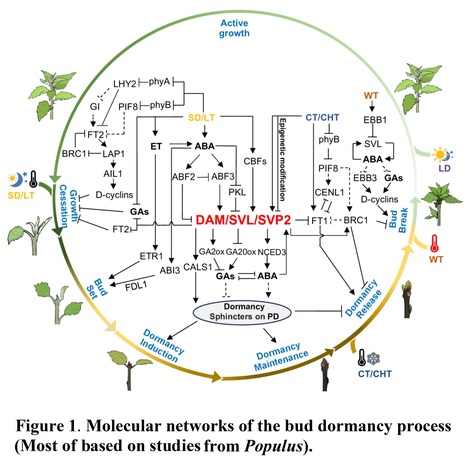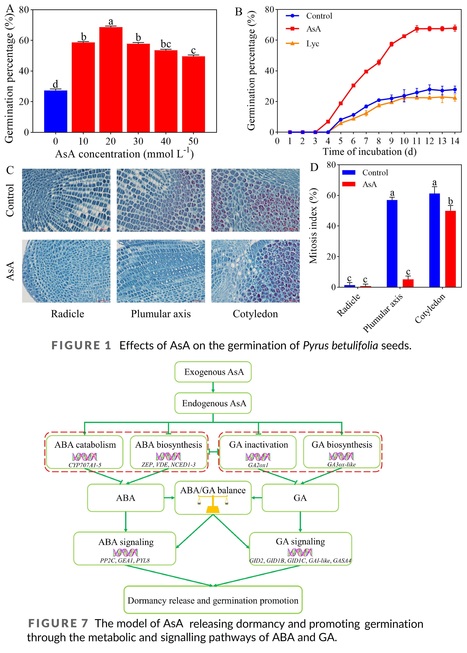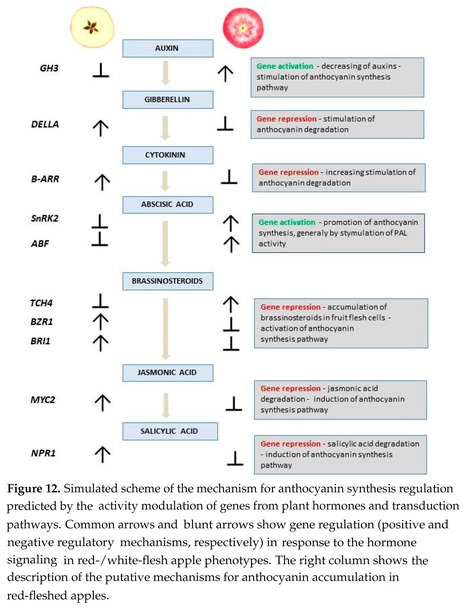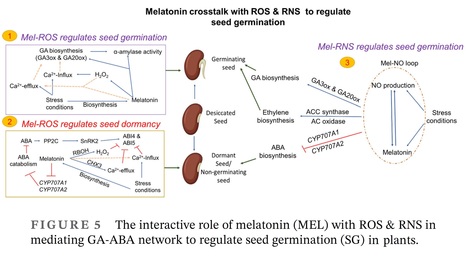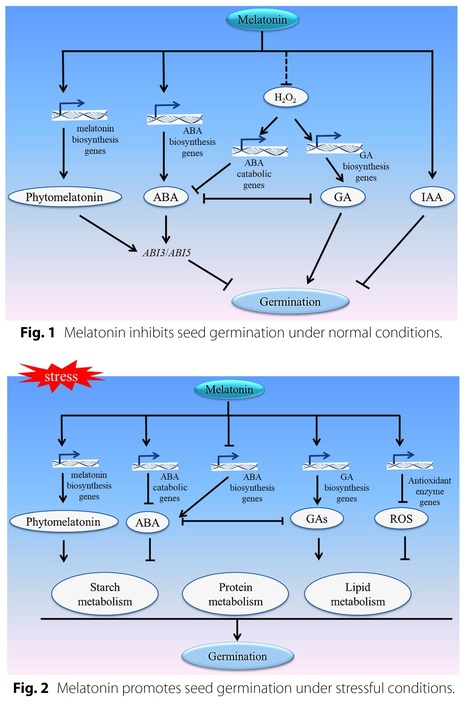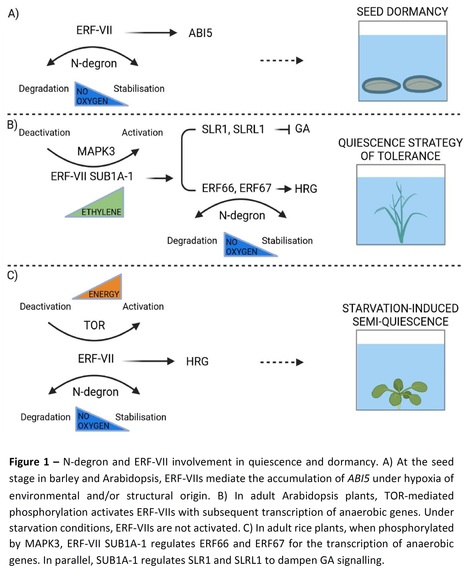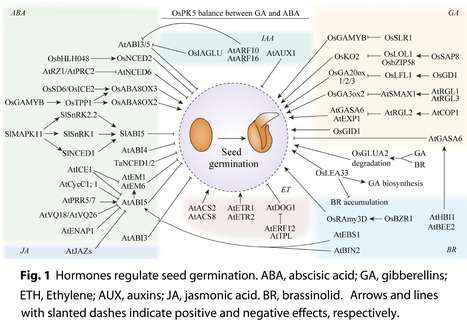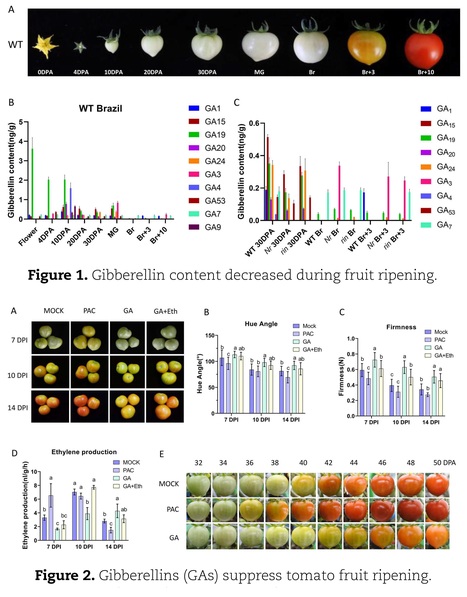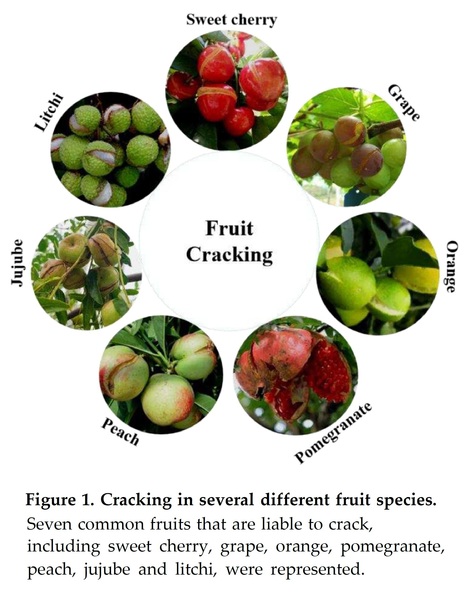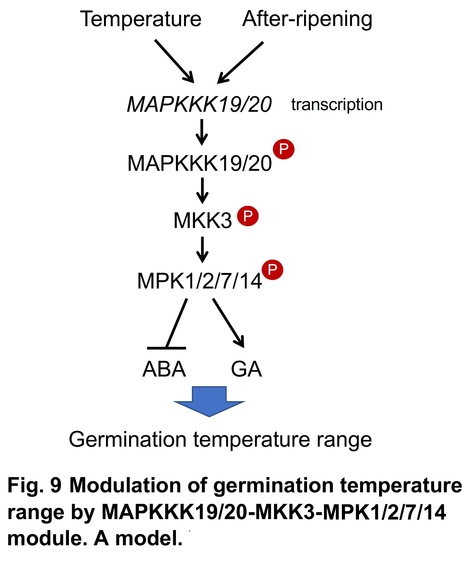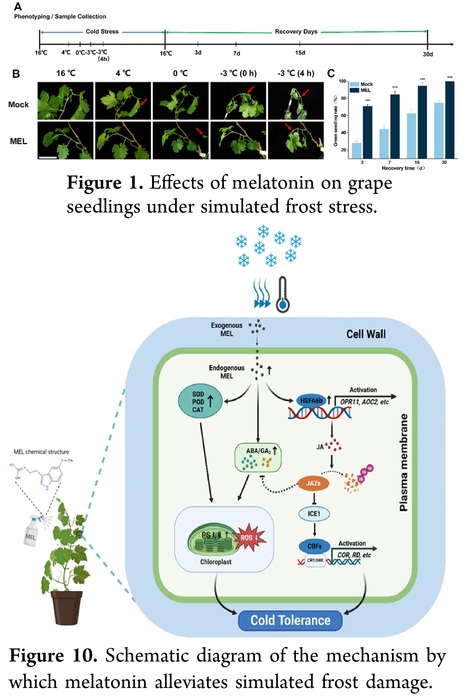 Your new post is loading...
 Your new post is loading...
Authors: Yakong Wang, Xiangyang Sun, Jun Peng, Fuguang Li, Faiza Ali and Zhi Wang.
Journal of Advanced Research (2024)
Highlights: • ROS, epigenetics, and hormones play crucial roles in regulating seed germination processes. • ROS regulates seed germination by influencing hormone levels through Ca2+, NO signaling, and MAPK cascade reaction. • ROS plays a role in seed germination through DNA methylation, chromatin remodeling, and protein post-translational modification. • Sophisticated feedback regulations between ROS, phytohormones, and epigenetic modifications determine seed germination.
Abstract: "Background -The whole life of a plant is regulated by complex environmental or hormonal signaling networks that control genomic stability, environmental signal transduction, and gene expression affecting plant development and viability. Seed germination, responsible for the transformation from seed to seedling, is a key initiation step in plant growth and is controlled by unique physiological and biochemical processes. It is continuously modulated by various factors including epigenetic modifications, hormone transport, ROS signaling, and interaction among them. ROS showed versatile crucial functions in seed germination including various physiological oxidations to nucleic acid, protein, lipid, or chromatin in the cytoplasm, cell wall, and nucleus. Aim of review - This review intends to provide novel insights into underlying mechanisms of seed germination especially associated with the ROS, and considers how these versatile regulatory mechanisms can be developed as useful tools for crop improvement. Key scientific concepts of review - We have summarized the generation and elimination of ROS during seed germination, with a specific focus on uncovering and understanding the mechanisms of seed germination at the level of phytohormones, ROS, and epigenetic switches, as well as the close connections between them. The findings exhibit that ROS plays multiple roles in regulating the ethylene, ABA, and GA homeostasis as well as the Ca2+ signaling, NO signaling, and MAPK cascade in seed germination via either the signal trigger or the oxidative modifier agent. Further, ROS shows the potential in the nuclear genome remodeling and some epigenetic modifiers function, although the detailed mechanisms are unclear in seed germination. We propose that ROS functions as a hub in the complex network regulating seed germination."
Authors: Hikaru Sato and Hisayo Yamane.
Journal of Experimental Botany (2024)
Abstract: "As sessile organisms, plants enter periods of dormancy in response to environmental stresses to ensure continued growth and reproduction in future. During dormancy, plant growth is suppressed, adaptive/survival mechanisms are exerted, and stress tolerance increases over a prolonged period until the plants resume their development or reproduction under favorable conditions. In this review, we focus on seed dormancy and bud dormancy, which are critical for adaptations to fluctuating environmental conditions. We provide an overview of the physiological characteristics of both types of dormancy as well as the importance of the phytohormones abscisic acid and gibberellin for establishing and releasing dormancy, respectively. Additionally, recent epigenetic analyses have revealed that dormancy establishment and release are associated with the removal and deposition of histone modifications at the loci of key regulatory genes influencing phytohormone metabolism and signaling, including DELAY OF GERMINATION 1 and DORMANCY-ASSOCIATED MADS-box genes. We discuss our current understanding of the physiological and molecular mechanisms required to establish and release seed dormancy and bud dormancy, while also describing how environmental conditions control dormancy depth, with a focus on the effects of histone modifications."
Authors: Da Zhang, Tan He, Xumin Wang, Chenchen Zhou, Youpeng Chen, Xin Wang, Shixiang Wang, Shuangcheng He, Yuan Guo, Zijin Liu and Mingxun Chen.
Plant Physiology (2024)
One-sentence summary: A MYB-like transcription factor positively modulates seed germination in response to salinity stress by regulating the expression of germination-associated genes.
Abstract: "Seed germination is a critical checkpoint for plant growth under unfavorable environmental conditions. In Arabidopsis (Arabidopsis thaliana), the abscisic acid (ABA) and gibberellic acid (GA) signaling pathways play important roles in modulating seed germination. However, the molecular links between salinity stress and ABA/GA signaling are not well understood. Herein, we showed that the expression of DIVARICATA1 (DIV1), which encodes a MYB-like transcription factor, was induced by GA and repressed by ABA, salinity, and osmotic stress in germinating seeds. DIV1 positively regulated seed germination in response to salinity stress by directly regulating the expression of DELAY OF GERMINATION 1-LIKE 3 (DOGL3) and GA-STIMULATED ARABIDOPSIS 4 (GASA4) and indirectly regulating the expression of several germination-associated genes. Moreover, NUCLEAR FACTOR-YC9 (NF-YC9) directly repressed the expression of DIV1 in germinating seeds in response to salinity stress. These results help reveal the function of the NF-YC9–DIV1 module and provide insights into the regulation of ABA and GA signaling in response to salinity stress during seed germination in Arabidopsis."
Authors: Jihua Ding, Kejing Wang, Shashank Pandey, Mariano Perales, Isabel Allona, Md Rezaul Islam Khan, Victor B. Busov, Rishikesh P. Bhalerao
Journal of Experimental Botany (2024)
Abstract: "Seasonal bud dormancy in perennial woody plants is a crucial and intricate process that is vital for the survival and development of plants. Over the past few decades, significant advancements have been made in understanding many features of bud dormancy, particularly in model species, where certain molecular mechanisms underlying this process have been elucidated. In this review, we provide an overview of recent molecular progress in understanding bud dormancy in trees, with a specific emphasis on the integration of common signaling and molecular mechanisms identified across different tree species. Additionally, we address some challenges that have emerged in the in-depth understanding of bud dormancy and offer insights for future studies."
Authors: Junpeng Niu, Mingzhen Xu, Na Zong, Jia Sun, Lei Zhao and Wei Hui.
Physiologia Plantarum (2024)
Abstract: "Seed dormancy is an important life history state in which intact viable seeds delay or prevent germination under suitable conditions. Ascorbic acid (AsA) acts as a small molecule antioxidant, and breaking seed dormancy and promoting subsequent growth are among its numerous functions. In this study, a germination test using Pyrus betulifolia seeds treated with exogenous AsA or AsA synthesis inhibitor lycorine (Lyc) and water absorption was conducted. The results indicated that AsA released dormancy and increased germination and 20 mmol L−1 AsA promoted cell division, whereas Lyc reduced germination. Seed germination showed typical three phases of water absorption; and seeds at five key time points were sampled for transcriptome analysis. It revealed that multiple pathways were involved in breaking dormancy and promoting germination through transcriptome data, and 12 differentially expressed genes (DEGs) related to the metabolism and signal transduction of abscisic acid (ABA) and gibberellins (GA) were verified by subsequent RT-qPCR. For metabolites, exogenous AsA increased endogenous AsA and GA3 but reduced ABA and the ABA/GA3 ratio. In addition, three genes regulating ABA synthesis were downregulated by AsA, while five genes mediating ABA degradation were upregulated. Taken together, AsA regulates the pathways associated with ABA and GA synthesis, catalysis, and signal transduction, with subsequent reduction in ABA and increase in GA and further the balance of ABA/GA, ultimately releasing dormancy and promoting germination."
Authors: Huibin Xu, Fuxiang Wang, Rebecca Njeri Damari, Xiaofeng Chen and Zhongyuan Lin.
Molecular Breeding (2024)
Abstract: "Seed germination is a vital step in the life cycle of a plant, playing a significant role in seedling establishment and crop yield potential. It is also an important factor in the conservation of plant germplasm resources. This complex process is influenced by a myriad of factors, including environmental conditions, the genetic makeup of the seed, and endogenous hormones. The perception of these environmental signals triggers a cascade of intricate signal transduction events that determine whether a seed germinates or remains dormant. Despite considerable progress in uncovering the molecular mechanisms governing these processes, many questions remain unanswered. In this review, we summarize the current progress in the molecular mechanisms underlying the perception of environmental signals and consequent signal transduction during seed germination, and discuss questions that need to be addressed to better understand the process of seed germination and develop novel strategies for germplasm improvement."
Authors: Júlia de Paiva Gonçalves, Karla Gasparini, Edgard T. Picoli, Maximiller Dal-Bianco Costa, Wagner L. Araujo, Agustin Zsögön and Dimas M. Ribeiro.
Journal of Plant Physiology (2024)
Abstract: "Seed development, dormancy, and germination are connected with changes in metabolite levels. Not surprisingly, a complex regulatory network modulates biosynthesis and accumulation of storage products. Seed development has been studied profusely in Arabidopsis thaliana and has provided valuable insights into the genetic control of embryo development. However, not every inference applies to crop legumes, as these have been domesticated and selected for high seed yield and specific metabolic profiles and fluxes. Given its enormous economic relevance, considerable work has contributed to shed light on the mechanisms that control legume seed growth and germination. Here, we summarize recent progress in the understanding of regulatory networks that coordinate seed metabolism and development in legumes."
Authors: Sylwia Keller-Przybylkowicz, Michal Oskiera , Xueqing Liu, Laiqing Song, Lingling Zhao, Xiaoyun Du, Dorota Kruczynska, Agnieszka Walencik, Norbert Kowara and Grzegorz Bartoszewski.
International Journal of Molecular Sciences (2024)
Abstract: "The red flesh coloration of apples is a result of a biochemical pathway involved in the biosynthesis of anthocyanins and anthocyanidins. Based on apple genome analysis, a high number of regulatory genes, mainly transcription factors such as MYB, which are components of regulatory complex MYB-bHLH-WD40, and several structural genes (PAL, 4CL, CHS, CHI, F3H, DFR, ANS, UFGT) involved in anthocyanin biosynthesis, have been identified. In this study, we investigated novel genes related to the red-flesh apple phenotype. These genes could be deemed molecular markers for the early selection of new apple cultivars. Based on a comparative transcriptome analysis of apples with different fruit-flesh coloration, we successfully identified and characterized ten potential genes from the plant hormone transduction pathway of auxin (GH3); cytokinins (B-ARR); gibberellins (DELLA); abscisic acid (SnRK2 and ABF); brassinosteroids (BRI1, BZR1 and TCH4); jasmonic acid (MYC2); and salicylic acid (NPR1). An analysis of expression profiles was performed in immature and ripe fruits of red-fleshed cultivars. We have uncovered genes mediating the regulation of abscisic acid, salicylic acid, cytokinin, and jasmonic acid signaling and described their role in anthocyanin biosynthesis, accumulation, and degradation. The presented results underline the relationship between genes from the hormone signal transduction pathway and UFGT genes, which are directly responsible for anthocyanin color transformation as well as anthocyanin accumulation during apple-fruit ripening."
Authors: Baoshan Xian, Muhammad Saad Rehmani, Yueni Fan, Xiaofeng Luo, Ranran Zhang, Jiahui Xu, Shaowei Wei, Lei Wang, Juan He, Aigen Fu and Kai Shu.
New Phytologist (2024)
Abstract: "Abscisic acid (ABA) and gibberellins (GA) antagonistically mediate several biological processes, including seed germination, but the molecular mechanisms underlying ABA/GA antagonism need further investigation, particularly any role mediated by a transcription factors module. Here, we report that the DELLA protein RGL2, a repressor of GA signaling, specifically interacts with ABI4, an ABA signaling enhancer, to act as a transcription factor complex to mediate ABA/GA antagonism. The rgl2, abi3, abi4 and abi5 mutants rescue the non-germination phenotype of the ga1-t. Further, we demonstrate that RGL2 specifically interacts with ABI4 to form a heterodimer. RGL2 and ABI4 stabilize one another, and GA increases the ABI4-RGL2 module turnover, whereas ABA decreases it. At the transcriptional level, ABI4 enhances the RGL2 expression by directly binding to its promoter via the CCAC cis-element, and RGL2 significantly upregulates the transcriptional activation ability of ABI4 toward its target genes, including ABI5 and RGL2. Abscisic acid promotes whereas GA inhibits the ability of ABI4-RGL2 module to activate transcription, and ultimately ABA and GA antagonize each other. Genetic analysis demonstrated that both ABI4 and RGL2 are essential for the activity of this transcription factor module. These results suggest that the ABI4-RGL2 module mediates ABA/GA antagonism by functioning as a double agent."
Authors: Lei Wang, Mohsin Tanveer, Hongling Wang and Marino B. Arnao.
Journal of Pineal Research (2024)
Abstract: "Seed germination (SG) is the first stage in a plant's life and has an immense importance in sustaining crop production. Abiotic stresses reduce SG by increasing the deterioration of seed quality, and reducing germination potential, and seed vigor. Thus, to achieve a sustainable level of crop yield, it is important to improve SG under abiotic stress conditions. Melatonin (MEL) is an important biomolecule that interplays in developmental processes and regulates many adaptive responses in plants, especially under abiotic stresses. Thus, this review specifically summarizes and discusses the mechanistic basis of MEL-mediated SG under abiotic stresses. MEL regulates SG by regulating some stress-specific responses and some common responses. For instance, MEL induced stress specific responses include the regulation of ionic homeostasis, and hydrolysis of storage proteins under salinity stress, regulation of C-repeat binding factors signaling under cold stress, starch metabolism under high temperature and heavy metal stress, and activation of aquaporins and accumulation of osmolytes under drought stress. On other hand, MEL mediated regulation of gibberellins biosynthesis and abscisic acid catabolism, redox homeostasis, and Ca2+ signaling are amongst the common responses. Nonetheless factors such as endogenous MEL contents, plant species, and growth conditions also influence above-mentioned responses. In conclusion, MEL regulates SG under abiotic stress conditions by interacting with different physiological mechanisms."
Authors: Guoling Guo, Haiyan Zhang, Weiyu Dong, Bo Xu, Youyu Wang, Qingchen Zhao, Lun Liu, Xiaomei Tang, Li Liu, Zhenfeng Ye, Wei Heng, Liwu Zhu and Bing Jia.
Journal of Integrative Agriculture (2024)
Abstract: "Drought stress represents a devastating natural disaster driven by the continuing intensification of global warming, which seriously threats the productivity and quality of several horticultural crops, including pear. Gibberellins (GAs) play crucial roles in plant growth, development, and responses to drought stress. Previous studies have shown significant reductions of GA levels in plants under drought stress; however, understanding of the intrinsic regulation mechanisms of GA-mediated drought stress in pear remains very limited. Here, we show that drought stress could impair the accumulation of bioactive GAs (BGAs), and subsequently identified PbrGA2ox1 as a chloroplast-localized GA deactivation gene, which was significantly induced by drought stress and abscisic acid (ABA) treatment, but was suppressed by GA3 treatment. PbrGA2ox1-overexpressing transgenic tobacco (Nicotiana benthamiana) plants exhibited enhanced tolerance to dehydration and drought stresses, whereas knock-down of PbrGA2ox1 in pear (Pyrus betulaefolia) by virus-induced gene silencing lead to elevated drought sensitivity. Transgenic plants were hypersensitive to ABA, and had a lower BGAs content, enhanced reactive oxygen species (ROS) scavenging ability, and augmented ABA accumulation and signaling under drought stress compared to wild-type plants. However, the opposite effects were observed with PbrGA2ox1 silencing in pear. Moreover, exogenous GA3 treatment aggravated the ROS toxification effect and restrained ABA synthesis and signaling, resulting in the compromised drought tolerance of pear. In summary, our results shed light on the mechanism by which BGAs are eliminated in pear leaves under drought stress, providing a further insight into the mechanism regulating the effects of the GA on the drought tolerance of plants."
Authors: Zizhao Xie, Liang Jin, Ying Sun, Chenghang Zhan, Siqi Tang, Tian Qin, Nian Liu and Junli Huang.
Plant Communications (2024)
Abstract: "The crosstalk between gibberellin (GA) and abscisic acid (ABA) signaling is crucial for balancing plant growth and adaption to environmental stress. Nevertheless, the molecular mechanism of mutual antagonism still needs to be well understood. In this study, we find that knockout of rice NAC (NAM, ATAF1/2, CUC2) transcription factor gene OsNAC120 inhibits plant growth while enhances drought tolerance, but its overexpression lines act in an opposite way. Exogenous GA can rescue the semi-dwarf phenotype of osnac120 mutants, and further study shows that OsNAC120 promotes GA biosynthesis through transcriptionally activating GA biosynthetic genes OsGA20ox1 and OsGA20ox3. DELLA protein SLENDER RICE1 (SLR1) interacts with OsNAC120 and impedes its transactivation ability, while GA treatment can remove the inhibition of transactivation activity caused by SLR1. On the other hand, OsNAC120 negatively regulates rice drought tolerance by repressing ABA-induced stomatal closure. Mechanistic investigation illustrates that OsNAC120 inhibits ABA biosynthesis via transcriptional repression of ABA biosynthetic genes OsNCED3 and OsNCED4. Rice OSMOTIC STRESS/ABA-ACTIVATED PROTEIN KINASE 9 (OsSAPK9) physically interacts with OsNAC120 and mediates its phosphorylation, which results in OsNAC120 degradation. ABA treatment accelerates OsNAC120 degradation and reduces its transactivation activity. Together, our findings provide the evidence that OsNAC120 plays critical roles in balancing GA-mediated growth and ABA-induced drought tolerance in rice. The research will help us understand the mechanisms underlying the “trade-off” between plant growth and stress tolerance, and engineer stress-resistant and high-yielding crops."
Authors: Ze Liu, Hengrui Dai, Jinjiang Hao, Rongrong Li, Xiaojun Pu, Miao Guan and Qi Chen.
Stress Biology (2023)
Abstract: "Seed germination is a complex process regulated by internal and external factors. Melatonin (N-acetyl-5-methoxytryptamine) is a ubiquitous signaling molecule, playing an important role in regulating seed germination under normal and stressful conditions. In this review, we aim to provide a comprehensive overview on melatonin's effects on seed germination on the basis of existing literature. Under normal conditions, exogenous high levels of melatonin can suppress or delay seed germination, suggesting that melatonin may play a role in maintaining seed dormancy and preventing premature germination. Conversely, under stressful conditions (e.g., high salinity, drought, and extreme temperatures), melatonin has been found to accelerate seed germination. Melatonin can modulate the expression of genes involved in ABA and GA metabolism, thereby influencing the balance of these hormones and affecting the ABA/GA ratio. Melatonin has been shown to modulate ROS accumulation and nutrient mobilization, which can impact the germination process. In conclusion, melatonin can inhibit germination under normal conditions while promoting germination under stressful conditions via regulating the ABA/GA ratios, ROS levels, and metabolic enzyme activity. Further research in this area will deepen our understanding of melatonin's intricate role in seed germination and may contribute to the development of improved seed treatments and agricultural practices."
|
Authors: Pierre Gautrat, Sanne E. A. Matton, Lisa Oskam, Siddhant S. Shetty, Kyra J. van der Velde and Ronald Pierik.
Journal of Experimental Botany (2024)
Abstract: "Plants growing in dense vegetation stands need to flexibly position their photosynthetic organs to ensure optimal light capture in a competitive environment. They do so through a suite of developmental responses referred to as the shade avoidance syndrome. Belowground, root development is also adjusted in response to aboveground neighbour proximity. Canopies are dynamic and complex environments with heterogeneous light cues in the far-red, red, blue and UV spectrum, which can be perceived with photoreceptors by spatially separated plant tissues. Molecular regulation of plant architecture adjustment via PHYTOCHROME-INTERACTING FACTOR (PIF) transcription factors and growth-related hormones such as auxin, gibberellic acid, brassinosteroids and abscisic acid were historically studied without much attention to spatial or tissue-specific context. Recent developments and technologies have, however, sparked strong interest in spatially explicit understanding of shade avoidance regulation. Other environmental factors such as temperature and nutrient availability interact with the molecular shade avoidance regulation network, often depending on the spatial location of the signals, and the responding organs. Here, we aim to review recent advances in how plants respond to heterogenous light cues and integrate these with other environmental signals."
Authors: Baolei Li and Jiaqi Sun.
Plant Physiology (2024)
Excerpt: "The functions of DIVARICATA (DIV) proteins, which belong to the MYB-like TF family, remain elusive (Fang et al., 2018). Six DIV genes have been identified in Arabidopsis based on their structural resemblance to the tomato I-box binding factor SlMYBI (Machemer et al., 2011). Among these, only DIV2 has been characterized as a positive regulator of seed germination in response to ABA and salt stress (Fang et al., 2018). However, the roles of the other DIV genes in the process of seed germination in response to salinity stress remain largely unexplored. In this issue of Plant Physiology, Zhang et al. (2024) provide evidence that DIV1 functions as a crucial integrative regulator that links salinity stress with ABA/GA signaling during seed germination."
"In summary, Zhang et al. (2024) illustrate the significant role of DIV1 as a positive regulator of Arabidopsis seed germination in response to salinity stress. DIV1 exerts a direct influence on ABA/GA signaling by promoting GASA4 expression and suppressing DOGL3 expression. Additionally, it indirectly modulates the expression of a series of germination-associated genes.
Authors: Sahana Basu, Monika, Surbhi Kumari and Gautam Kumar.
Plant Physiology and Biochemistry (2024)
Highlights: • IAA induces lateral root formation in rice under submergence • ROS and RNS cause lysigenous aerenchyma formation in root cortex of rice • Submergence decreases ABA level, causing GA-mediated escape response in rice shoot • Enhanced antioxidant levels dampen nitro-oxidative damage during de-submergence
Abstract: "Constant change in global climate has become the most important limiting factor to crop productivity. Asymmetrical precipitations are causing recurrent flood events around the world. Submergence is one of the most detrimental abiotic stresses for sustainable rice production in the rainfed ecosystems of Southeast Asia. Therefore, the development of submergence-tolerant rice is an essential requirement to encounter food security. Submergence tolerance in rice is governed by the major quantitative trait locus (QTL) designated as Submergence1 (Sub1) near the centromere of chromosome 9. The introduction of the Sub1 in high-yielding rice varieties producing near-isogenic lines (NILs) has shown extreme submergence tolerance. The present study aimed to understand the responses of rice genotype IR64 and its Sub1 NIL IR64 Sub1 following one week of complete submergence treatment. Submergence imposed severe nitro-oxidative stress in both the rice genotypes, consequently disrupting the cellular redox homeostasis. In this study, IR64 exhibited higher NADPH oxidase activity accompanied by increased reactive oxygen species, reactive nitrogen species, and malondialdehyde buildups and cell death under submergence. Higher accumulations of 1-Aminocyclopropane-1-carboxylic acid, gibberellic acid, and Indole-3-acetic acid were also observed in IR64 which accelerated the plant growth and root cortical aerenchyma development following submergence. In contrast, IR64 Sub1 had enhanced submergence tolerance associated with an improved antioxidant defense system with sustainable morpho-physiological activities and restricted root aerenchyma formation. The comprehensive analyses of the responses of rice genotypes with contrasting submergence tolerance may demonstrate the intricacies of rice under complete submergence and may potentially contribute to improving stress resilience by advancing our understanding of the mechanisms of submergence tolerance in rice."
Authors: Chiara Pucciariello and Pierdomenico Perata.
Journal of Experimental Botany (2024)
Abstract: "Plant quiescence and seed dormancy can be triggered by reduced oxygen availability. Under water, oxygen depletion caused by flooding can culminate in a quiescent state, which is a plant strategy for energy preservation and survival. In adult plants, a quiescent state can be activated by sugar starvation, culminating in metabolic depression. In seeds, secondary dormancy can be activated by reduced oxygen availability, which creates an unfavourable state for germination. The physical dormancy of some seeds and buds includes barriers to external conditions, which indirectly results in hypoxia. The molecular processes that support seed dormancy and plant survival through quiescence under hypoxia include the N-degron pathway, which enables the modulation of ethylene responsive factors of group VII and downstream targets. This oxygen- and nitric oxide-dependent mechanism interacts with phytohormone-related pathways to control growth."
Authors: Jia Zhao, Yongqi He, Hongsheng Zhang and Zhoufei Wang.
Seed Biology (2024)
Abstract: "Seed germination is a key process in the life cycle of seed plants. The initiation of seed germination requires the activity of specific internal signaling molecules, such as hormones and reactive oxygen species (ROS), and is dependent on external environmental factors, such as water, temperature, and light. Seed germination is a complex trait that is regulated by multiple factors, including transcript, protein, and metabolite levels. This review highlights current knowledge relating to the regulatory roles of hormones, ROS, small RNAs, epigenetic modifications, post-translational modifications, and environmental cues on seed germination, mainly focusing on Arabidopsis and rice. The review on the molecular regulation of seed germination contributes to the improvement of crop seed quality using bio-breeding approaches."
Authors: Foziya Altaf, Shazia Parveen, Sumira Farooq, Mohammad Lateef Lone, Aehsan Ul Haq and Inayatullah Tahir
Theoretical and Experimental Plant Physiology (2024)
Abstract: "Due to the already strained and severely challenged agricultural ecosystems of the modern world, predicted changes in life cycle of plants, including leaf senescence are receiving significant attention from stakeholders. The onset, progression and terminal phases of leaf senescence are greatly influenced by plant hormones. The senescence of leaves is accelerated by ethylene, jasmonic acid (JA), salicylic acid (SA), abscisic acid (ABA), brassinosteroids and strigolactones (SLs), whereas it is postponed by cytokinins (CKs), gibberellic acid (GA) and auxins. The crosstalk and signal transduction pathways between these growth regulators have been found to regulate leaf senescence by orchestrating various developmental and environmental factors. Premature leaf senescence lessens the plant’s nutritional capacity and shortens the vegetative production schedule, prompting an early transition from the vegetative to the reproductive stage and diminishing crop potential. As a result, a complete understanding of leaf senescence and finding novel ways to delay it is crucial for agricultural productivity. The ability to manipulate leaf senescence for agricultural enhancement has been made possible by significant advances in physiological and molecular awareness of leaf senescence. Although studies pertaining to leaf senescence have been given steadily more attention, there are still numerous challenges that need to be resolved. In this perspective, this review focuses on current advances in understanding the leaf senescence by molecular and genetic analyses with an emphasis on hormonal regulation of leaf senescence. We also hypothesize future research to better comprehend leaf senescence by employing various current technologies."
Authors: Mengbo Wu, Kaidong Liu, Honghai Li, Ying Li, Yunqi Zhu, Dan Su, Yaoxin Zhang, Heng Deng, Yikui Wang and Mingchun Liu.
Horticulture Research (2024)
Abstract: "The phytohormone ethylene is well known for its important role in the ripening of climacteric fruit, such as tomato (Solanum lycopersicum). However, the role and mode of action of other plant hormones in climacteric fruit ripening regulation are not fully understood. Here, we showed that exogenous GA treatment or increasing endogenous gibberellin content by overexpressing the gibberellin synthesis gene SlGA3ox2 specifically in fruit tissues delayed tomato fruit ripening, whereas treatment with the GA biosynthesis inhibitor paclobutrazol (PAC) accelerated fruit ripening. Moreover, exogenous ethylene treatment cannot completely reverse the delayed fruit ripening phenotype. Furthermore, exogenous GA treatment of ethylene signalling mutant Never ripe (Nr) or SlEBF3-overexpressing lines still delayed fruit ripening, suggesting that GA involved in fruit ripening partially depends on ethylene. Transcriptome profiling showed that gibberellin affect the ripening of fruits by modulating the metabolism and signal transduction of multiple plant hormones, such as auxin and abscisic acid, in addition to ethylene. Overall, the results of this study provide new insight into the regulation of gibberellin in fruit ripening through mediating multiple hormone signals."
Authors: Mengmeng Zhang, Yiteng Liu, Zhuo Chen, Zhaokun Zhi, A-ning Wang, Huafeng Yue, Fangdong Li, Shulin Zhang and Gao-Pu Zhu.
Preprints (2024)
Abstract: "Fruit cracking or splitting, a severe physiological disease that highly affects appearance and quality, compromise the commodity value of fruit and also causes huge economical losses to the producers of several fleshy fruit crops. The growth-promoting phytohormone gibberellic acid (GA) and growth-inhibiting phytohormone abscisic acid (ABA) antagonistically regulate numerous developmental processes throughout the plant life cycle. Homeostasis of endogenous GA and ABA play a significant role in the normal growth of fruits, and its imbalance may lead to the occurrence of cracking or splitting during the process of fruit growth, development, ripening and postharvest storage. The pathways of GA and ABA metabolism and signaling have been studied widely, and the major components were well characterized, which including the genes encoding major biosynthesis and catabolism enzymes and the key signaling components. Nevertheless, our knowledge of the mechanisms of GA and ABA governing fruit cracking is not comprehensive enough. In this review, we not only focus on the scenarios of effects of endogenous GA and ABA contents in the fruit and exogenous plant growth regulators GA and ABA treatments, but also endeavor to provide some genetic cues on the function of GA and ABA responsible for fruit cracking modulation. Information from this review aims to strengthen the understanding of potential molecular bases underlying GA and ABA in fruit cracking control and provide guidance in breeding of fruit cultivars with cracking-resistant ideotypes, and also make great theoretical significance in guiding the establishment of integrated prevention and control measures to fruit cracking or splitting."
Authors: Masahiko Otani, Ryo Tojo, Sarah Regnard, Lipeng Zheng, Takumi Hoshi, Suzuha Ohmori, Natsuki Tachibana, Tomohiro Sano, Shizuka Koshimizu, Kazuya Ichimura, Jean Colcombet and Naoto Kawakami.
bioRxiv (2024)
Abstract: "Temperature is a major environmental cue for seed germination. The permissive temperature range for germination is narrow in dormant seeds and expands during after-ripening. Quantitative trait loci analyses of pre-harvest sprouting in cereals have revealed that MKK3, a mitogen-activated protein kinase (MAPK) cascade protein, is a negative regulator of grain dormancy. Here we show that the MAPKKK19/20-MKK3-MPK1/2/7/14 cascade modulates germination temperature range in Arabidopsis seeds by elevating germinability of the seeds at sub- and supra-optimal temperatures. The expression of MAPKKK19 and MAPKKK20 is regulated by an unidentified temperature sensing and signaling mechanism the sensitivity of which is modulated during after-ripening of the seeds, and MPK7 is activated at the permissive temperature for germination regulated by expression levels of MAPKKK19/20. Activation of the MKK3 cascade represses abscisic acid (ABA) biosynthesis enzyme gene expression, and induces expression of ABA catabolic enzyme and gibberellic acid biosynthesis enzyme genes, resulting in expansion of the germinable temperature range. Our data demonstrate that the MKK3 cascade integrates temperature and after-ripening signals to germination processes including phytohormone metabolism."
Authors: Nikita Sajeev, Maarten Koornneef and Leónie Bentsink.
The Plant Cell (2024)
Abstract: "Seeds are unique time capsules that can switch between 2 complex and highly interlinked stages: seed dormancy and germination. Dormancy contributes to the survival of plants because it allows to delay germination to optimal conditions. The switch between dormancy and germination occurs in response to developmental and environmental cues. In this review we provide a comprehensive overview of studies that have helped to unravel the molecular mechanisms underlying dormancy and germination over the last decades. Genetic and physiological studies provided a strong foundation for this field of research and revealed the critical role of the plant hormones abscisic acid and gibberellins in the regulation of dormancy and germination, and later natural variation studies together with quantitative genetics identified previously unknown genetic components that control these processes. Omics technologies like transcriptome, proteome, and translatomics analysis allowed us to mechanistically dissect these processes and identify new components in the regulation of seed dormancy and germination."
Authors: Chi-Chieh Hu, Chin-Yu Wu, Min-Yu Yang, Jian-Zhi Huang, Chih-Wen Wu and Chwan-Yang Hong.
Plant Cell Reports (2024)
Key message: The inhibitory effect of eugenol on rice germination is mediated by a two-step modulatory process: Eugenol first regulates the antagonism of GA and ABA, followed by activation of catalase activity.
Abstract: "The natural monoterpene eugenol has been reported to inhibit preharvest sprouting in rice. However, the inhibitory mechanism remains obscure. In this study, simultaneous monitoring of GA and ABA responses by the in vivo GA and ABA-responsive dual-luciferase reporter system showed that eugenol strongly inhibited the GA response after 6 h of imbibition, whereas eugenol significantly enhanced the ABA response after 12 h of imbibition. Gene expression analysis revealed that eugenol significantly induced the ABA biosynthetic genes OsNCED2, OsNCED3, and OsNCED5, but notably suppressed the ABA catabolic genes OsABA8ox1 and OsABA8ox2. Conversely, eugenol inhibited the GA biosynthetic genes OsGA3ox2 and OsGA20ox4 but significantly induced the GA catabolic genes OsGA2ox1 and OsGA2ox3 during imbibition. OsABI4, the key signaling regulator of ABA and GA antagonism, was notably induced before 12 h and suppressed after 24 h by eugenol. Moreover, eugenol markedly reduced the accumulation of H2O2 in seeds after 36 h of imbibition. Further analysis showed that eugenol strongly induced catalase activity, protein accumulation, and the expression of three catalase genes. Most importantly, mitigation of eugenol-inhibited seed germination was found in the catc mutant. These findings indicate that catalase associated with antagonistic changes of ABA and GA is involved in the sequential regulation of eugenol-inhibited seed germination in rice."
Authors: Junduo Li, Kai Lv, Jieping Wu, Yaping Xie, Junxia Zhang, Ningbo Zhang and Weirong Xu.
Journal of Agricultural and Food Chemistry (2023)
Abstract: "Melatonin (MEL) is an antioxidant molecule that enhances plant tolerance to environmental stress. However, the mechanisms by which MEL regulates cold signaling pathways in grapes under cold stress remain elusive. Here, we investigated the physiological and transcriptomic changes in grape seedlings treated with exogenous MEL to determine their protective role under cold stress. Results showed that 150 μM MEL effectively attenuated cold-induced cell damage by reducing reactive oxygen species (ROS) and preserving the chloroplast structure and function. MEL also inhibited tannin degradation, which contributed to its protective effect. Exogenous MEL promoted the synthesis of endogenous MEL, abscisic acid, auxin, and cytokinin while inhibiting gibberellin. Transcriptomic profiling revealed 776 differentially expressed transcripts in MEL-treated samples compared to controls. Functional analysis of a candidate hub gene, VvHSFA6b, showed that its overexpression in grape calli enhances cold tolerance by activating jasmonic acid synthesis pathway genes, promoting JA accumulation, and inhibiting JAZ-repressed transcription factors."
|




 Your new post is loading...
Your new post is loading...


